This is an old revision of this page, as edited by Peter243 (talk | contribs) at 19:55, 26 October 2006. The present address (URL) is a permanent link to this revision, which may differ significantly from the current revision.
Revision as of 19:55, 26 October 2006 by Peter243 (talk | contribs)(diff) ← Previous revision | Latest revision (diff) | Newer revision → (diff) Place in Ontario, Canada| City of Toronto | |
|---|---|
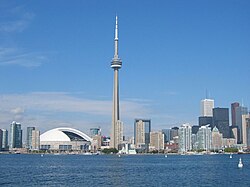 | |
 FlagOfficial seal of City of TorontoSeal FlagOfficial seal of City of TorontoSeal | |
| Motto: Diversity Our Strength | |
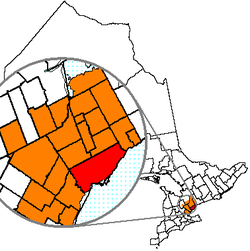 | |
| Country | Canada |
| Province | Ontario |
| Established | March 6, 1834 |
| Amalgamated | January 1, 1998 |
| Government | |
| • Mayor | David Miller |
| • Council | Toronto City Council |
| Population | |
| • City | 2,481,494 (2,001 census) |
| • Urban | 4,366,508 (2,001 census) |
| • Metro | 5,304,100 (2,005 census) |
| Website | www.city.toronto.on.ca |
Toronto (officially the City of Toronto) is the largest city in Canada and the provincial capital of Ontario, located on the northwestern shore of Lake Ontario. With a population of 2.48 million, it is the fifth-most populous municipality in North America after Mexico City, New York City, Los Angeles and Chicago. The City of Toronto is at the heart of the Greater Toronto Area and is part of a densely-populated region in south-central Ontario (and recently, Upstate New York) known as the Golden Horseshoe. Residents of Toronto are called Torontonians.
As Canada's economic hub and a major world city, Toronto is highly-developed in the sectors of finance, telecommunications, transportation, media, publishing, software production and medical research. The city is home to the iconic CN Tower and many national and transnational corporate head offices. With the help of immigration, Toronto has a very cosmopolitan population representing cultures and ethnicities from around the world. Because of its low crime, clean environment and generally high standard of living, the city is consistently rated one of the world's most livable cities by the Economist Intelligence Unit.
History
The first European presence was established by French traders at Fort Rouillé in 1750, on the current Exhibition Grounds. The first influx of Europeans was the result of United Empire Loyalists fleeing to unsettled lands north of Lake Ontario during the American Revolutionary War. With its natural protected harbour, the settlement served as a British naval base.
The town was named York by Lieutenant-Governor John Graves Simcoe in 1793, when he selected it to replace Newark as the capital of Upper Canada. By 1800, the town was still smaller than Kingston, and consisted of probably not more than fifty families. In 1813, as part of the War of 1812, York was captured and major buildings were burned by American soldiers. The town's surrender was negotiated by John Strachan.
The city grew rapidly through the remainder of the 19th century, as a major destination for immigrants to Canada. On March 6, 1834, York reverted to its original Iroquois name of Toronto. By then a bustling steamboat entry port, the city's development was aided by the addition of gaslit street lights and sewers. Toronto's growth further accelerated after it was linked by rail to the Upper Great Lakes in 1854. Industrialization in the 1870s ensured Toronto's place as a major economic centre in the new Canadian Confederation.
By the 1920s, Toronto's population and economic importance in Canada was surpassed only by Montreal, and in 1934 the Toronto Stock Exchange had become the largest in the country. The city experienced an influx of immigrants following the Second World War and sustained immigration after 1970. By the 1980s, Toronto had emerged as Canada's most populous city and the generally-acknowledged economic hub. The city became home to a majority of corporate headquarters in Canada and the largest banking and exchange centre.
In 1954, the City of Toronto was federated into a regional government known as Metropolitan Toronto. The postwar boom had resulted in rapid suburban development, and it was believed that a coordinated land use strategy and shared services would provide greater efficiency for the region. The metropolitan government began to manage services that crossed municipal boundaries, including highways, water and public transit. In 1967, the seven smallest municipalities of the region were merged into their larger neighbours, resulting in a six-city configuration that includes City of Toronto and the surrounding municipalities of East York, Etobicoke, North York, Scarborough and York.
In 1998, the metropolitan government was dissolved and the six municipalities were amalgamated into a single municipality, creating of the current City of Toronto.
Origin of name
Main article: Toronto's nameToronto is an Iroquois word meaning "place where trees stand in the water". It refers to the area north and south of what is now Lake Simcoe (then known as "Lake Toronto"), where the Huron Indians planted tree saplings to corral fish. The portage between Lake Ontario and Lake Huron along this route was called the Toronto Portage.
Geography and climate
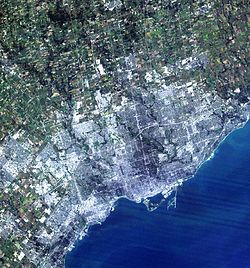
Topography
Toronto covers an area of 629.91 square kilometres (243.21 sq mi), with a maximum north-south distance of 21 kilometres (13 mi) and a maximum east-west distance of 43 kilometres (27 mi). It is bounded by Lake Ontario to the south, Etobicoke Creek and Highway 427 to the west, Steeles Avenue to the north and the Rouge River to the east.
The city is further intersected by two other rivers and numerous tributaries: the Humber River in the west end and the Don River east of downtown. The many creeks and rivers create large tracts of densely-forested ravines, and provide ideal sites for parks and recreational trails. However, the ravines also interfere with the city's grid plan, and this results in major thoroughfares such as Finch Avenue, Leslie Street, Lawrence Avenue, St. Clair Avenue and Keele Street terminating on one side of ravines and continuing on the other side. Others thoroughfares such as the Bloor Street-Danforth Avenue viaduct require bridges to span above the ravines.
During the last ice age, the present site of Toronto was beneath Glacial Lake Iroquois. Today, a series of escarpments mark the lake's former boundary, known as the Iroquois Shoreline. The escarpments are most prominent from Victoria Park Avenue to the mouth of Highland Creek, where they form the Scarborough Bluffs. Other noticeable sections include the area near St. Clair Avenue West between Bathurst Street and the Don River, and south of Davenport Road from Caledonia to Spadina Avenue.
Climate
Toronto's climate is moderated by its southerly location within Canada and its proximity to Lake Ontario; its climate is among the mildest of any place in Canada east of the Rocky Mountain range. The city experiences four distinct seasons with considerable variance in daily temperature, particularly during the winter months.
Toronto winters are usually accompanied by several cold snaps where maximum temperatures drop to the -10 °C (14 °F) to -15 °C (5 °F) range, often made to feel colder by windchill. Mild days also occur throughout winter, with temperatures around 5 – 9°C (40 – 50 °F). The average maximum temperature in January is -2.1 °C (28.2 °F), and the average minimum is -10.5 °C (13.1 °F). Summer in Toronto is characterized by long stretches of humid weather. The average July maximum temperature is 26.8 °C (80 °F), and the average minimum is 14.8 °C (58.6 °F). Daytime temperatures sometimes approach or exceed 35 °C (95 °F), but usually for very brief periods.
Precipitation is fairly evenly distributed throughout the year, but summer is usually the wettest season. The average yearly precipitation is 793 millimetres (31.7 in.), with an average annual snowfall of about 115 centimetres (46 in.).
Cityscape


Downtown remains the most densely-populated section of Toronto. At the heart of Downtown lies the city's Financial District along Bay Street. The district contains the largest cluster of skyscrapers in Canada, including the First Canadian Place, Toronto Dominion Centre, Scotia Plaza, Royal Bank Plaza, Commerce Court and BCE Place. Downtown, Midtown and Uptown also contain many historically wealthy enclaves such as Yorkville, Rosedale, The Annex, Forest Hill, Lawrence Park, Moore Park, and Casa Loma. These neighbourhoods generally feature upscale residences, luxury condominiums and high-end retail and services. At the same time, the Downtown vincinity includes neighbourhoods with a high proportion of recent immigrants living in social housing and rental highrises, such as St. Jamestown, Regent Park and Parkdale.
The city has a major downtown, and many smaller downtowns, such as midtown, uptown, and Scarborough City Centre. Thorncliffe Park, central York and central Etobicoke are also examples of this, but to a much lesser extent.
The inner-city districts of York and East York are older, traditionally middle-class sections that became ethnically diverse in recent decades. Many neighbourhoods in the inner suburbs experienced accelerated gentrification as a result of increasing population and a housing boom that ran through the late 1990s and early 2000s. The first neighbourhoods affected were Leaside and North Toronto, gradually progressing into the western neighbourhoods in York. Much of the housing in these areas consist of post-World War I single-family homes, but many of them are in the process of being replaced or remodelled.
The outer districts of Etobicoke, Scarborough and North York are much more suburban, although they largely retain the grid patterns of the streets laid down before the post-war suburban development, many from towns that existed prior to their creation as cities. Upscale neighborhoods include Bridle Path in North York, the area surrounding the Scarborough Bluffs in Guildwood, and most of central Etobicoke, such as Humber Valley Village, and The Kingsway. Other sections contain large apartment blocks of low-income families, mixed with typical detached housing found in suburbia.
Demographics

The last complete census by Statistics Canada estimated there were 2,481,494 people residing in Toronto in 2001. The city's population grew by 4 percent between 1996 and 2001, at an annualized rate of 0.8 percent. Persons aged 14 years and under made up 17.5 percent of the population, and those aged 65 years and over made up 13.6 percent. The median age of the population was 36.9 years. As of July 1, 2006, the population is estimated at 2,629,030.
With a long history as a major destination for immigrants to Canada, Toronto is one of the world's most multicultural cities. As of 2001, more than 40 percent of the city's residents belong to a visible minority group, and visible minorities are projected to comprise a majority in Toronto by 2017.. According to the United Nations Development Programme, Toronto has the second-highest percentage of foreign-born population among world cities, after Miami, Florida. While Miami's foreign-born population consists mostly of Cubans and other Latin Americans, no single nationality or culture dominates Toronto's immigrant population.
The countries of foreign-born residents with the largest presence in Toronto are Italy, Jamaica, Pakistan, India, Iran, China, Sri Lanka, Portugal, Poland, Ghana, Korea, Philippines, Trinidad, Somalia, Ecuador, Vietnam, Russia, and Guyana. This diversity is reflected in Toronto's ethnic neighbourhoods, such as Little Italy, Little Jamaica, Little India, Chinatown, Koreatown, Malta Village, Greektown, Portugal Village, Corso Italia, Augusta Avenue and Little Mogadishu.
Christianity is the largest religious group in Toronto. The 2001 census reports that 31.4 percent of the city's population is Roman Catholic, followed by Protestants at 21.2 percent, Eastern Orthodox Christians at 4.9 percent and other Christians at 3.9 percent. Islam is the second largest religion in the city, with Muslims accounting for 6.7 percent of the population, while Judaism comprise 4.2 percent, Hinduism comprise 4.8 percent, Sikhism comprise 0.9 percent, Buddhism comprise 2.7 percent and other Eastern Religions comprise 0.2 percent. Another 18.9 percent of the population profess no faith.
While English is the predominant language spoken by Torontonians, a few other languages have considerable numbers of local speakers, including Italian, Chinese, Portuguese, Tamil, Persian, Spanish and Punjabi. After English, Italian is second-most widely-spoken language used at work. As a result, the city's 9-1-1 emergency services are equipped to respond in multiple languages.
Government

Toronto is a single-tier municipality governed by a mayor-council system. The Toronto City Council is a unicameral body, comprised of a mayor elected by direct popular vote and 44 councillors respresenting geographical wards throughout the city. All members of the city council, including the mayor, serve three-year terms without term limits. (After the 2006 municipal election, members of the council will serve four-year terms.)
The city council is divided into six standing committees with between 9 and 12 members: policy and finance, administration, works, economic development and parks, community services, and planning and transportation. Additionally, the city has four community councils that make recommendations on local matters to the city council, but possess no final authority. Each city councillor serves as a member on a community council.
Toronto has an operating budget of C$7.1 billion. The city receives funding from the Government of Ontario in addition to tax revenues, including $2.5 billion dollars for mandated purposes, $2.0 billion for special-purpose bodies such as the Toronto Public Library and Toronto Zoo, $1.7 billion of directly-controlled funds, and $900 million for capital financing and non-programs.
Torontonians are represented at the federal and provincial governments by 22 Members of Parliament in the House of Commons and another 22 Members of Provincial Parliament in the Legislative Assembly of Ontario.
Economy

Toronto is a major international centre for business and finance. Generally considered the financial capital of Canada, Toronto has a high concentration of banks and brokerage firms on Bay Street, the country's equivalent to Wall Street in New York. The Toronto Stock Exchange is the world's sixth-largest stock exchange by market capitalisation. All of the Big Five banks of Canada are headquartered in Toronto.
Toronto has a gross domestic product of US$225 billion. The gross metropolitan product of its metropolitan area is about US$305 billion, seventh-largest in the world after New York City, London, Tokyo, Paris, Los Angeles and Chicago.
The city is a national centre for the media, publishing, telecomunications and information technology industries; it is home to Thomson Corporation, Bell Globemedia, Rogers Communications and Celestica. Other prominent Canadian corporations in Toronto include Four Seasons Hotels, the Hudson's Bay Company and Manulife Financial. Most multinational companies also establish their Canadian head offices in Toronto.
Although much of the region's manufacturing activities take place outside the city limits, Toronto continues to be an important wholesale and distribution point for the industrial sector. The city's strategic position along the Quebec City-Windsor Corridor and its extensive road and rail connections help support the nearby production of motor vehicles, iron, steel, food, machinery, chemicals and paper. The completion of the St. Lawrence Seaway in 1959 gave ships access to the Great Lakes from the Atlantic Ocean.
Education

Toronto is home to a diverse range of public and private educational institutions. The Toronto District School Board operates more than 500 public schools and is the largest school board in Canada. Additionally, the Toronto Catholic District School Board manages the city's publicly-funded Roman Catholic schools, while the Conseil scolaire de district catholique Centre-Sud manages public French-language schools. There are also numerous private university-preparatory schools, such as the Toronto French School, Upper Canada College, St. Michael's College School, Havergal College, Bishop Strachan School, De La Salle College, and Crescent School.
The University of Toronto, established in 1827, is the oldest university in the province of Ontario and a leading research institution. The city is also home to Ryerson University, York University and the Ontario College of Art & Design.
There are five diploma-granting community colleges in Toronto: Seneca College, Humber College, Centennial College, Sheridan College and George Brown College. The Royal Conservatory of Music, which includes The Glenn Gould School, is a major music school located in downtown. The Canadian Film Centre is a film, television and new media training institute founded by filmmaker Norman Jewison.
The Toronto Public Library is the largest public library system in Canada, consisting of 99 branches with more than 11 million items in its collection.
Culture
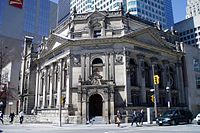
Toronto is a major scene for theatre and other performing arts, with more than fifty ballet and dance companies, six opera companies and two symphony orchestras. The city is home to the Canadian Opera Company and the Toronto Symphony Orchestra. Major performance venues include the Four Seasons Centre for the Performing Arts, Roy Thomson Hall, the Princess of Wales Theatre, the Royal Alexandra Theatre, Massey Hall, the Toronto Centre for the Arts, the Elgin Teatre, the Winter Garden Theatre and the Hummingbird Centre. Ontario Place features the world's first permanent IMAX movie theatre, the Cinesphere, as well as the Molson Amphitheatre, an open-air venue for large-scale music concerts. Each summer, the Canadian Stage Company presents an outdoor Shakespeare production in Toronto’s High Park called "Dream in High Park". Canada's Walk of Fame acknowledges the achievements of successful Canadians, with of a series of stars on designated blocks of sidewalks along King Street and Simcoe Street.
The Distillery District is a pedestrian village containing boutiques, art galleries, restaurants, artist studios and small breweries, including the well-known Mill Street Brewery. A new theatre in the district, the Young Centre for the Performing Arts, is the home of the Soulpepper Theatre Company and the drama productions of nearby George Brown College.
The production of domestic and foreign film and television is a major local industry. Toronto often stands in on screen for large American cities like New York and Chicago. Many movie releases are screened in Toronto prior to wider release in North America. The Toronto International Film Festival is one of the most important annual events for the international film industry.
Sites of interest
Toronto's best-known landmark is the CN Tower, which currently stands as the tallest free-standing land structure in the world at 553 metres (1,815 ft).
The Royal Ontario Museum is a major museum for world culture and natural history. The Art Gallery of Ontario contains a large collection of Canadian, European, African and contemporary artwork. The Canadian National Exhibition is held annually at Exhibition Place. The Don Valley Brick Works has recently been restored as a park and heritage site.
The Bloor-Yorkville neighbourhood is one of Toronto's most elegant shopping and dining areas. Other notable neightbourhoods and places include the Beaches, the Toronto Islands, Kensington Market, the Toronto Eaton Centre, and the Hockey Hall of Fame.
See also: Category:Buildings and structures in TorontoMedia

Toronto is Canada's largest media market. It is home of the national dailies The Globe and Mail and the National Post, as well as the local papers Toronto Star and the Toronto Sun. It contains the headquarters to the major Canadian television networks, including the national public broadcaster CBC and the largest private broadcaster CTV. The bulk of Canada's publishing industry is also located in Toronto.
Sports
Further information: List of sports teams in TorontoToronto is the only Canadian city with representation in major league baseball, basketball and ice hockey through MLB, NBA and NHL teams. It also has teams in Canadian football, lacrosse and football (soccer) with teams in leagues such as the CFL, NLL and MLS. The city's major sports complexes include the Air Canada Centre and the Rogers Centre.
In addition to team sports, both thoroughbred and standardbred horseracing are conducted at Woodbine Race Track in Rexdale.
Historic sports clubs of Toronto include the Granite Club (est. 1836), the Royal Canadian Yacht Club (est. 1852), the Toronto Cricket Skating and Curling Club (est. pre-1827), the Argonaut Rowing Club (est. 1872), the Toronto Lawn Tennis Club (est. 1881), and the Badminton and Racquet Club (est. 1924).
| Club | League | Sport | Venue | Established | Championships |
|---|---|---|---|---|---|
| Toronto Blue Jays | MLB | Baseball | Rogers Centre | 1977 | 2 |
| Toronto Raptors | NBA | Basketball | Air Canada Centre | 1995 | 0 |
| Toronto Argonauts | CFL | Football | Rogers Centre | 1873 |
15 |
| Toronto Maple Leafs | NHL | Hockey | Air Canada Centre | 1917 | 13 |
| Toronto Maple Leafs | IBL | Baseball | Christie Pits | 1969 | 7 |
| Toronto Lynx | USL | Soccer | Centennial Park Stadium | 1997 | 0 |
| Toronto St. Michaels Majors | OHL | Ice Hockey | St. Michael's College School Arena | 1997 | 0 |
| Toronto Rock | NLL | Indoor Lacrosse | Air Canada Centre | 1998 | 5 |
| Toronto Marlies | AHL | Ice Hockey | Ricoh Coliseum | 2005 | 0 |
| Toronto FC | MLS | Soccer | BMO Field | 2007 | 0 |
Infrastructure
Health and medicine

Toronto is home to the Hospital for Sick Children, Mount Sinai Hospital, St. Michael's Hospital, Toronto General Hospital, Sunnybrook Health Sciences Centre, Princess Margaret Hospital among others and the University of Toronto Faculty of Medicine.
Toronto's "Discovery District" is centre of research in biomedicine. It is located on a 2.5 square kilometre research park that is fully integrated into Toronto’s downtown core. It is also home to the MaRS (Medical and Related Sciences) Centre, which was created in 2000 to capitalize on the research and innovation strength of the Province of Ontario, and to position Canada for leadership in the highly competitive global innovation economy.
See also: XVI International AIDS Conference, 2006Transportation
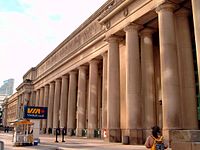
Toronto has one of the largest public transit systems in North America. Canada's busiest airport, Toronto Pearson International Airport (YYZ), is located along the city's western boundary with Mississauga. The city also has a smaller commercial airport, the politically contentious Toronto City Centre Airport (usually called the "Island Airport"), located on the Toronto Islands.
The Government of Ontario operates an extensive rail and bus transit system called GO Transit that links the neighbouring cities and suburbs with the City of Toronto. Thirty-eight trains on seven train lines run 179 trips, and carry over 160,000 passengers a day. An additional 288 buses feed the main rail lines. The Toronto Transit Commission (TTC) provides public transit within the City of Toronto. Its backbone is the city's subway system, which includes the "U"-shaped north-south Yonge-University-Spadina line, the east-west Bloor-Danforth line, the east-west Sheppard line through the northern part of the city, and the Scarborough RT line running through the eastern part of the city (Scarborough). The TTC also operates an extensive network of buses and streetcars.
See also
References
Footnotes
|
Other references
|
External links
- City of Toronto - Official website for the City of Toronto.
Other Wiki sites
- Wikitravel Toronto - Toronto travel guide at Wikitravel.
- Wikia Toronto - Toronto wiki at Wikia.com.
| Places adjacent to Toronto | ||||||||||||||||
|---|---|---|---|---|---|---|---|---|---|---|---|---|---|---|---|---|
| ||||||||||||||||
| Ontario | ||
|---|---|---|
| Government |  | |
| Geography | ||
| Culture | ||
| Economy | ||
| Transportation | ||
| History | ||
Template:Largest and smallest census divisions of Canada by area Template:Largest and smallest census divisions of Canada by population
Categories: